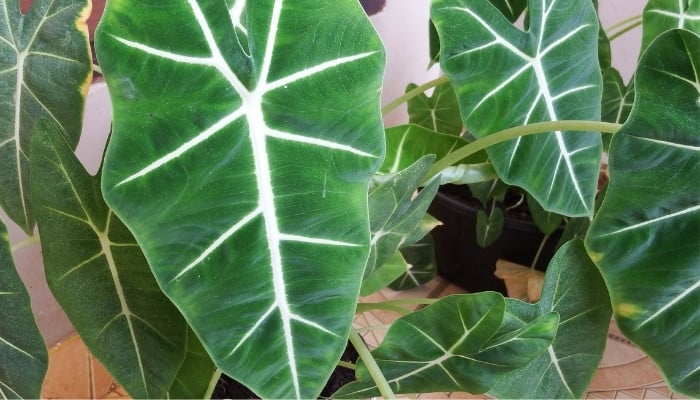The Anthurium crystallinum, a tropical charmer, captivates with its big, oval (nearly heart-shaped) vibrant green leaves. However, what really sets it apart is the distinct glimmer in its veins, providing an elegant and velvety gloss – hence it’s crucial to understand how to care for this beautiful foliage.
How do you care for Anthurium crystallinum? Anthurium crystallinum plants require conditions similar to their native Panama rain forest region, so this calls for 70-80% humidity, moderate sunlight, and a moist soil medium. Monthly fertilizer can further enhance growth and encourage flowering, provided its nutritional needs are met.
Caring for Anthurium Crystallinum: Basic Guidelines
This lush tropical plant can also be grown outside in appropriately humid climates, though they are commonly kept indoors due to their frost tenderness and need for partial shade.
Find out how you can care for an Anthurium crystallinum with our guide to their ideal environment, pro tips on dealing with pests, and more.
Complete Care Guide for Anthurium Crystallinum
The Anthurium crystallinum species was first described in 1873 by Belgian botanist Jean Jules Linden and his colleague Éduard-François André, a French landscape architect.
The name crystallinum refers to the gem-like glisten that can be seen on the leaves in bright light – just one of many attractive features that have made this houseplant such a joy for collectors.
Anthurium Crystallinum at a Glance
- Plant Type: Tropical perennial
- Scientific Name: Anthurium crystallinum
- Average Height: 1.5 meters
- Average Width: 0.5 meters
- Growth Rate: Slow
- Produces Flowers: Yes
- Common Pests: Scale insects, mealybugs
- Life Expectancy: 10+ years with good care
- Difficulty of Care: Medium
What To Do When You First Get Your Anthurium Crystallinum
- Look out for pests – Small bugs and insects may have hitched a lift in transit, especially in humid conditions, so check the foliage and soil for any intruders (tips on common pest signs and solutions later).
- Feel the soil for moisture – Dig your finger into the top 2 inches of soil to determine if it needs watering. Water it immediately if it feels bone dry. Otherwise, let the soil remain moist and check back the following day.
- Keep it in a safe location – As this plant is toxic, it should be grown out of reach from children and pets. Placing it on a shelf or tall sturdy stool can be a great spot, as long as the lighting is suitable.
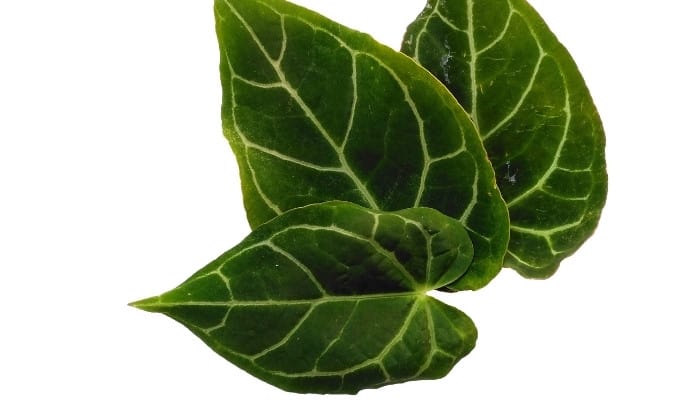
Ideal Soil for Anthurium Crystallinum
The perfect soil medium should keep the plant moist while encouraging drainage.
Biologist and author of the Indoor Garden Nook blog Sara E. Taylor recommends a 1:1:1 ratio of peat moss, coconut fiber, and orchid or pine bark.
This “mimics their natural habitat, holds moisture and creates porous pockets of air to help the roots reach the minerals.”
Anthurium Crystallinum Water Requirements
Anthurium crystallinum love moist, not soggy soil, so let the top inches dry out in between waterings.
Watering three times a week may be necessary during summer, but in cooler months, you many only need to water as little as once every two weeks.
Use distilled or filtered tap water if you have high fluoride levels in your area.
Anthurium Crystallinum Lighting Needs
These plants require a moderate amount of light with partial shade to replicate the filtered light in the rain forest canopy, so within 5 feet of a west or eastern-facing window is ideal.
Consider using LED lamps to meet lighting conditions in winter or shadier homes.
Ideal Temperature Range for Anthurium Crystallinum
Anthurium crystallinum plants do best in temperatures between 65-75°F (18-24°C).
Long exposure to temperatures outside this range can cause foliage fading, scorching, and eventual death, so take care to keep it away from heaters and air conditioners.
Ideal Humidity Level for Anthurium Crystallinum
Humidity levels of around 70-80% will help this plant thrive.
Regular misting can be beneficial if you live in a particularly dry, hot climate, and investing in a humidifier (I love the ambiance this whisper-quiet model provides) can help you maintain the right conditions.
Best Location for Anthurium Crystallinum
Placing your Anthurium crystallinum inside or near the bathroom or kitchen (preferably on a windowsill) will be an ideal spot to soak up the sun and humidity it needs.
Just ensure that it is not likely to be directly splashed as prolonged exposure to excess moisture can eventually cause root damage.
Anthurium Crystallinum Growth Habits
This is a ‘self-heading’ plant, in other words, its tough sturdy stems help it grow upright, though its steady outward growth of foliage gives it a compact shrub-like form.
Fertilization Type & Schedule for Anthurium Crystallinum
A water-soluble organic fertilizer is best, and the more organic your soil content is (i.e. orchid/pine bark additives), the less it’ll need fertilizing.
Feed your Anthurium crystallinum a nitrogen-rich organic fertilizer (this organic liquid worked well for me) once monthly diluted to half strength between April and October.
Signs of Nutrient Deficiency
Yellowing or brown leaves are usually signs your plant has been overwatered or lacks the correct humidity level in its environment, impacting how well the roots take on nutrients.
Maintaining the right conditions and ensuring the soil mix is adequately porous can prevent deficiencies.
Pruning Anthurium Crystallinum
Pruning is occasionally required to remove dead or badly damaged (excessively discolored, wilting) leaves.
Trim decaying foliage with sterilized pruning shears at the base of the stem, and use protective gloves when doing so as the sap may cause skin irritation.
Does Anthurium Crystallinum Produce Flowers?
This plant will flower, though due to the flowers’ unshowy nature, this plant is grown more for its foliage.
Flowers grow in clusters on the stem in small green or yellow buds, but with exceptional care, these can bloom into peace lily-type spathes (flowering spikes surrounded by a colored leaf bracket).
Is Anthurium Crystallinum Toxic?
The sap of all Anthurium plants contains insoluble oxalic crystals which, when ingested, can cause oral and intestinal irritation, breathing difficulties, and allergic reactions in humans and pets, according to Pet Poison Helpline and the ASPCA.
Anthurium Crystallinum Propagation
Anthurium crystallinum plants can be propagated (creating new offspring plants) by either seed germination or root division, though the latter is the most reliable method since conditions have to be quite precise for seeds to flourish.
Wait until your plant is fairly mature (at least 12 months old) before attempting propagation by root division.
1. Remove the Plant From Its Pot and Remove the Soil
In summer and when the soil is moist from a recent watering, carefully slide the bare plant base out from its container pot and gently break off the soil until the root system is exposed.
The roots will resemble a crown with subdivisions or “root balls” where the stems shoot out.
2. Untangle the Roots and Divide Into Root Ball Sections
Gently untangle entwined roots and note where the main root crown splits off into separate root balls.
Begin carefully separating your chosen root ball sections by hand, or cut them off from the main crown using a sharp, sterilized knife.
3. Plant the Newly Divided Root Sections Into New Pots
Place each new root division into its own pot with drainage holes, using a suitable soil mix.
It helps to prepare the new pots beforehand by filling each a 1/3 of the way to help stabilize the new plant sections.
Once planted, water each one well, and return the parent plant to its original pot.
4. Encourage High Humidity With Jar Coverings
After finding a suitable spot for the new plants, try promoting suitably humid air straightaway by placing a glass bell jar over each of the pots for the first week or so.
Expert gardener and writer Christine Walkden advises “placing a rock under one edge of the jar to encourage circulation and prevent mold.”
Repotting Anthurium Crystallinum
Your Anthurium crystallinum plant will occasionally need repotting to give it a fresh lease on life and allow you to examine the soil for issues.
When To Repot Anthurium Crystallinum
Repotting is necessary every 2 years at the most and is best done during spring and summer when your plant will be most receptive to being rehomed.
Your plant will begin to outgrow its current pot size every couple of years and become rootbound as roots take up more space in the soil.
It can also be at risk of developing fungal infections in aged soil, causing discolored, wilting foliage and poor growth.
Signs That It’s Time To Repot
- Discolored leaves
- Generally poor growth
- Overgrown roots visible in the soil and protruding beneath the pot holes
How To Repot Anthurium Crystallinum
1. Prepare a Clean New Pot & Fill It With the Ideal Soil Mix
Disinfect and prepare a plant pot at least 2 inches larger than your current one, and fill it a 1/3 of the way with new soil mix.
If you were previously using commercial potting soil, this is a good opportunity to upgrade your soil recipe and use organic fibers to open up the soil and improve nutrient intake.
2. Remove Your Plant From Its Old Pot & Check Its Roots
Gently remove your plant from its current container pot and break apart the soil using your hands, or use a knife if it’s a little tough.
Carefully detangle the roots and check them for signs of fungal infection (black color, mushy texture).
Healthy roots should be pale and firm to the touch (super healthy roots will have a subtle pink tinge), so remove diseased areas with a sharp knife as needed.
3. Re-plant Clean, Healthy Roots Into the New Pot & Water Immediately
Place the healthy remains of your plant in the new pot and fill it with the remaining 2/3 of soil mix.
Water it straightaway and check that it drains well.
Find a suitably warm, humid home for your newly repotted Anthurium crystallinum, and let it adjust to the trauma of being moved – so hold off from fertilizer for a week or so.
Anthurium Crystallinum Common Problems & Solutions That Work
Anthurium Crystallinum Common Pests
This plant can be prone to a couple of sap-sucking pests which can devastate foliage if left untreated.
Thankfully they can be managed effectively once you know what to look for.
Scale Insects
- Signs of Trouble – Brown rice-shaped “bumps” on leaf undersides, and sticky honeydew residue on foliage.
- Solution – Wipe off using a damp cloth, misting affected areas to wash them off.
- Prevention – Agriculturist Bonnie L. Grant recommends a pyrethrin-based insecticide as this “contains a natural active ingredient found in chrysanthemum plants” to prevent harm to your Anthurium crystallinum.
Mealybugs
- Signs of Trouble – Cotton-wool-like specks on foliage or soil, and/or yellowing leaves.
- Solution – Mist directly with a 1:1 solution of water and rubbing alcohol to dissolve them.
- Prevention – Poke them off the foliage and out of the soil by hand as they are easy to spot.
Anthurium Crystallinum Common Diseases
Maintaining essential soil and environmental needs can prevent this plant from running into certain health conditions, but if you do spot the following, take immediate action.
Leaf Spot Fungus
- Signs of Trouble – Yellow-edged leaves with jagged or circular brown spots.
- Solution – Prune off affected leaves at the stem, isolate the plant to prevent the spread to other plants. Apply an organic fungicide treatment (I use the neem-oil-based spray).
- Prevention – Water at soil level to reduce leaf moisture, review watering routine, and improve air circulation with a gentle nearby fan.
Nutrient Deficiency
- Signs of Trouble – Unusually slow growth, yellowing/dull foliage.
- Solution – Repot in fresh soil or switch to an all-purpose fertilizer.
- Prevention – Allow soil to dry in between waterings, and check soil drainage and root health.
Other Common Problems
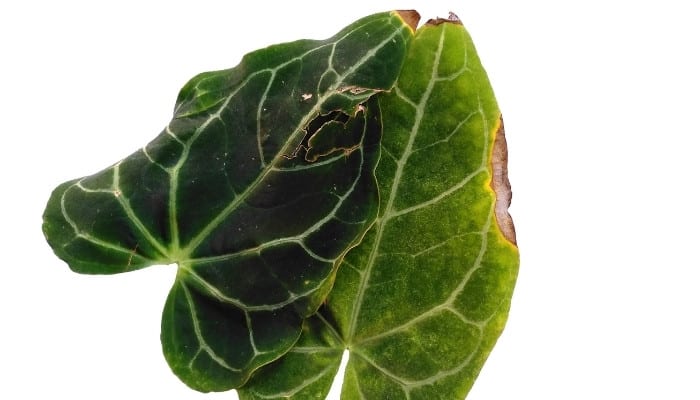
In addition to pest/disease control, you must stay consistent with your daily care to keep your Anthurium crystallinum plant in good condition.
If not, expect these common foliage changes:
Yellowing Leaves
- Signs of Trouble – Sudden yellow foliage.
- Solution – Prune badly discolored leaves, and aerate the soil with a dowel or chopstick to ensure water is reaching the roots and not staying too moist on top.
- Prevention – Increase air humidity with more frequent misting or purchase a humidifier.
Brown Leaves
- Signs of Trouble – Brown edges, decayed leaf ends.
- Solution – Trim discolored edges in line with leaf shape, allow the soil to dry out before next watering.
- Prevention – Keep the plant away from direct sunlight, and review watering routine.
Anthurium Crystallinum Common Questions
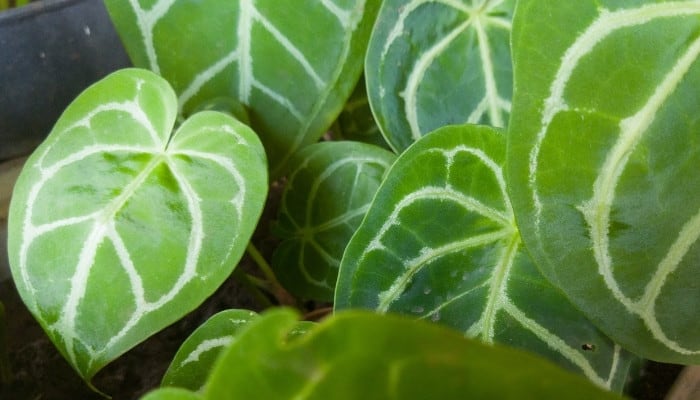
What Is the Average Crystal Anthurium Price?
The sought-after shape and appearance of its foliage prices the Anthurium crystallinum between $130-$150 across most online retailers.
Is Anthurium Crystallinum Fast Growing?
This plant tends to be a slow grower, particularly under low-light conditions.
Unless you live in a consistently bright climate, using LED grow lights will help it develop quicker indoors, especially during winter.
How Long Does It Take for Anthurium Crystallinum To Grow?
It can take between 2-5 years for an Anthurium crystallinum plant to reach full maturity.
Soil quality, environmental conditions, fertilizer use, and pest control can all be factors in growth rate.
How Big Do Anthurium Crystallinum Leaves Get?
At full maturity, the leaves of Anthurium crystallinum measure 12 inches across, achieving a foliage spread of about 0.5 meters (19 inches).
The leaves can grow to a maximum height of about 1.5 meters (60 inches).
Should I Mist Anthurium Crystallinum?
Yes, this plant will benefit from regular misting (at least three times a week) to maintain its required 70-80% humidity range, though it’s important to keep areas adequately ventilated as overly hot, moist conditions can contribute to leaf spot fungus.
How Long Do Anthurium Crystallinum Plants Live?
Under ideal growing conditions, your Anthurium crystallinum should have a lifespan of 10 years or more.
Things like dry air, temperature drops, direct sunlight, and sitting in overly moist soil (thereby rotting the roots) are all quick ways to kill this plant.
How Long Do Anthurium Crystallinum Flowers Last?
With exceptional care, flowers can bloom throughout the year and may last for a few months at a time, though this is much more likely when these plants are grown outdoors in tropical climates.
How Do You Get Crystal Anthurium To Bloom?
A fertilizer containing nitrogen, magnesium, calcium, and phosphorus is recommended to encourage flower growth.
“A high-quality Orchid fertilizer provides a good balance of these” advocates author of the Plantophiles blog Marcel Iseli.
Poor light and watering levels will stop flower growth in its tracks, so review these conditions too.
Is Epsom Salt Good for Crystal Anthuriums?
In small doses, the magnesium and sulfur content in Epsom salt can be beneficial for Anthurium crystallinum plants.
Author of The Bulb-o-licious Garden Nikki Phipps recommends a misting solution of “1 tbsp of salt (15 ml) per gallon” (or 1 tsp per large glass of water), “to improve flower blooming and enhance green foliage color.”
What Is Anthurium Crystal Hope?
This is a Costa Rican variety bred from hybrid Anthurium crystallinum plants in 1995 and features darker green leaves with more distinct silvery leaf veination in comparison to its parent plants.
It’s also less susceptible to leaf fungus and often grows no larger than 8 inches tall with a 5-inch foliage spread.
What’s the Difference Between Anthurium Clarinervium and Crystallinum?
Anthurium clarinervium is a smaller variety with darker green leaves and has a greater tolerance to cooler temperatures than Anthurium crystallinum.
These plants also produce flowers in ideal lighting and require the same careful watering schedule, soil, and humidity levels to thrive.
Anthurium Crystallinum vs. Magnificum
As its name suggests, Anthurium magnificum is a giant variety with a colossal foliage spread of 24 inches and a height of 60 inches.
It features darker green leaves with more prominent white veining, though it requires similar care as Anthurium crystallinum in terms of frequent fertilizing, well-draining soil, and moderate sunlight.
3 Key Tips for Success With Anthurium Crystallinum
1. Commit to Regular & Specific Fertilizing for Flowering
As flower production is rare indoors, you’ll need to stick with a specific weekly fertilizer solution to see results.
Biologist Sara E. Taylor advocates the use of organic over chemical fertilizer, one ideally containing nitrate-nitrogen over ammonium-nitrogen due to the latter’s toxicity, as this “slow-release formula is more likely to encourage the formation of flowers.”
2. Flush the Soil Regularly To Remove Salt Buildup
If you’re going to fertilize frequently, then a degree of damage control is needed.
As a trade-off for better growth, fertilizer use leaves excess salt deposits in the soil, disrupting the pH of the mix and damaging roots in the long-term.
Flush out this buildup in the soil every 3-6 months with lukewarm water.
3. Maintain High Humidity With Hacks (Or Invest in a Humidifier)
Since consistent humidity is so crucial in helping this plant prosper, have plenty of humidity hacks at the ready.
Budget hacks like setting up a pebble tray and early morning misting for maximum absorbency can help you get started.
In the long term, think about getting a humidifier to achieve tropical conditions like a plant pro.
Conclusion
To summarize, Anthurium crystallinum plants flourish in environments that balance high humidity with adequate ventilation to keep fungal infections at bay.
As flower production can be rare, it’s important to prioritize foliage and root health above all else by following a careful watering regimen, providing ideal lighting, and using a pro-recommended soil recipe.
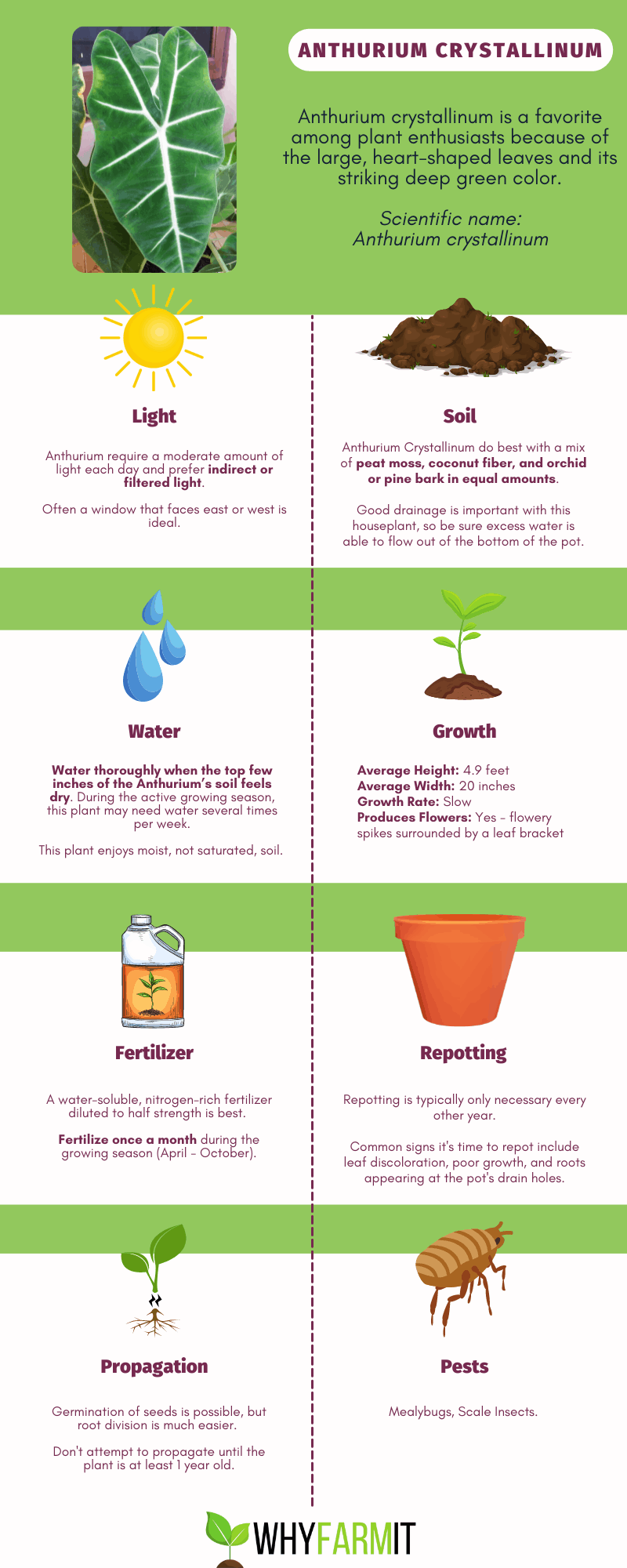
Sources:
https://en.hortipedia.com/Anthurium_crystallinum
https://www.gardeningknowhow.com/plant-problems/disease/plant-leaf-spots.htm
https://plantophiles.com/plant-care/anthurium-crystallinum/
https://www.petpoisonhelpline.com/poison/anthurium/
https://indoorgardenook.com/anthurium-crystallinum-care/
https://rootedhues.com/blogs/plant-care/anthurium-crystallinum-care-guide
https://www.guide-to-houseplants.com/glass-cloche.html
https://www.gardeningknowhow.com/houseplants/anthurium/anthurium-plant-pests.htm
https://houseplanthelp.com/anthurium-leaves-brown-spots/
https://travaldo.blogspot.com/2021/06/anthurium-crystallinum-crystal-anthur.html
https://academic.oup.com/jxb/article/68/10/2581/3079358
https://forums.botanicalgarden.ubc.ca/threads/anthurium-in-trouble.58867/
https://www.gardeningknowhow.com/garden-how-to/soil-fertilizers/epsom-salt-gardening.htm

